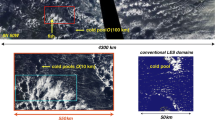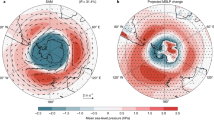Abstract
Mid-latitude weather systems are key contributors to the transport of atmospheric water vapour, but less is known about the role of the boundary layer in this transport. We expand a conceptual model of dry boundary-layer structure under synoptic systems to include moist processes, using idealised simulations of cyclone waves to investigate the three-way interaction between the boundary layer, atmospheric moisture and large-scale dynamics. Forced by large-scale thermal advection, boundary-layer structures develop over large areas, analogous to the daytime convective boundary layer, the nocturnal stable boundary layer and transitional regimes between these extremes. A budgeting technique demonstrates the key role of boundary-layer processes in the transport of moisture. Moisture is evaporated from the ocean behind the cold front and in the high-pressure part of the wave, and transported large distances within the boundary layer into the footprint of the warm-conveyor belt. The warm-conveyor belt forms one of the two main processes of boundary-layer ventilation, with shallow cumulus convection being of similar importance.
Similar content being viewed by others
References
Adamson DS, Belcher SE, Hoskins BJ, Plant RS (2006) Boundary-layer friction in midlatitude cyclones. Q J Roy Meteorol Soc 132: 101–124
Balasubramanian G, Garner ST (1997) The role of momentum fluxes in shaping the life cycle of a baroclinic wave. J Atmos Sci 54: 510–533
Beare RJ (2007) Boundary layer mechanisms in extratropical cyclones. Q J Roy Meteorol Soc 133: 503–515
Beare RJ, MacVean MK (2004) Resolution sensitivity and scaling of large-eddy simulations of the stable boundary layer. Boundary-Layer Meteorol 112: 257–281
Becker A, Kraus H, Ewenz CM (1996) Frontal substructures within the planetary boundary layer. Boundary-Layer Meteorol 78: 165–190
Beljaars ACM, Holtslag AAM (1991) Flux parameterization over land surfaces for atmospheric models. J Appl Meteorol 30: 327–341
Berger BW, Friehe CA (1995) Boundary-layer structure near the cold front of a marine cyclone during “ERICA”. Boundary-Layer Meteorol 73: 227–253
Boutle IA, Beare RJ, Belcher SE, Plant RS (2007) A note on boundary-layer friction in baroclinic cyclones. Q J Roy Meteorol Soc 133: 2137–2141
Brown AR, Beare RJ, Edwards JM, Lock AP, Keogh SJ, Milton SF, Walters DN (2008) Upgrades to the boundary-layer scheme in the Met Office numerical weather prediction model. Boundary-Layer Meteorol 128: 117–132
Browning KA (1990) Organization of clouds and precipitation in extratropical cyclones. In: Newton CW, Holopainen EO (eds) Extratropical cyclones: the Erik Palmén Memorial Volume. American Meteorological Society, Boston, pp 129–153
Businger JA, Charnock H (1983) Boundary layer structure in relation to larger-scale flow: Some remarks on the JASIN observations. Phil Trans Roy Soc Lond A 308: 445–449
Eady ET (1949) Long waves and cyclone waves. Tellus 1: 33–52
Eckhardt S, Stohl A, Wernli H, James P, Forster C, Spichtinger N (2004) A 15-year climatology of warm conveyor belts. J Climate 17: 218–237
Emanuel K, Fantini M, Thorpe A (1987) Baroclinic instability in an environment of small stability to slantwise moist convection. Part I: Two-dimensional models. J Atmos Sci 44: 1559–1573
Field PR, Wood R (2007) Precipitation and cloud structure in midlatitude cyclones. J Climate 20: 233–254
Gutowski WJ, Jiang W (1998) Surface-flux regulation of the coupling between cumulus convection and baroclinic waves. J Atmos Sci 55: 940–953
Gutowski WJ, Branscome LE, Stewart DA (1992) Life cycles of moist baroclinic eddies. J Atmos Sci 49: 306–319
Kuo YH, Reed RJ, Low-Nam S (1991) Effects of surface energy fluxes during the early development and rapid intensification stages of seven explosive cyclones in the Western Atlantic. Mon Weather Rev 119: 457–476
Levy G (1989) Surface dynamics of observed maritime fronts. J Atmos Sci 46: 1219–1232
Lock AP, Brown AR, Bush MR, Martin GM, Smith RNB (2000) A new boundary layer mixing scheme. Part I: scheme description and single-column model tests. Mon Weather Rev 128: 3187–3199
Mahrt L (1991) Boundary-layer moisture regimes. Q J Roy Meteorol Soc 117: 151–176
Martin GM, Ringer MA, Pope V, Jones A, Dearden C, Hinton T (2006) The physical properties of the atmosphere in the new Hadley Centre global environment model (HadGEM1). Part I: model description and global climatology. J Climate 19: 1274–
Neiman PJ, Shapiro MA, Donall EG, Kreitzberg CW (1990) Diabatic modification of an extratropical marine cyclone warm sector by cold underlying water. Mon Weather Rev 118: 1576–1590
Nuss WA (1989) Air-sea interaction influences on the structure and intensification of an idealized marine cyclone. Mon Weather Rev 117: 351–369
Pavan V, Hall N, Valdes P, Blackburn M (1999) The importance of moisture distribution for the growth and energetics of mid-latitude systems. Ann Geophys 17: 242–256
Polvani LM, Esler JG (2007) Transport and mixing of chemical airmasses in idealized baroclinic life cycles. J Geophys Res 112: D23,102
Sinclair VA, Gray SL, Belcher SE (2008) Boundary-layer ventilation by baroclinic life cycles. Q J Roy Meteorol Soc 134: 1409–1424
Sinclair VA, Belcher SE, Gray SL (2010) Synoptic controls on boundary-layer characteristics. Boundary-Layer Meteorol. doi:10.1007/s10546-009-9455-6
Taylor PK, Guymer TH (1983) The structure of an atmospheric warm front and its interaction with the boundary layer. Phil Trans Roy Soc Lond A 308: 341–358
Thorncroft CD, Hoskins BJ, McIntyre ME (1993) Two paradigms of baroclinic-wave life-cycle behaviour. Q J Roy Meteorol Soc 119: 17–55
Troen I, Mahrt L (1986) A simple model of the atmospheric boundary layer; sensitivity to surface evaporation. Boundary-Layer Meteorol 37: 129–148
Wernli H, Fehlmann R, Lüthi D (1998) The effect of barotropic shear on upper-level induced cyclogenesis: Semigeostrophic and primitive equation numerical simulations. J Atmos Sci 55: 2080–2094
Author information
Authors and Affiliations
Corresponding author
Rights and permissions
About this article
Cite this article
Boutle, I.A., Beare, R.J., Belcher, S.E. et al. The Moist Boundary Layer under a Mid-latitude Weather System. Boundary-Layer Meteorol 134, 367–386 (2010). https://doi.org/10.1007/s10546-009-9452-9
Received:
Accepted:
Published:
Issue Date:
DOI: https://doi.org/10.1007/s10546-009-9452-9




